Birds have been adapting to human activity for millennia
Roughly 14,500 to 10,500 years ago, in the transition from the last glacial period, humans harvesting vegetation from the wetlands of eastern Jordan created a habitat for birds that would otherwise have migrated, a new study reveals. It shows that human activity is not necessarily detrimental to biodiversity but may allow for species to co-inhabit specific environments, the researchers suggest.

The presence of humans is usually associated with negative effects on flora and fauna, and our species has demonstrably influenced biodiversity negatively in the course of history.
But in a new study published in the Journal of Archaeological Method and Theory, a team of researchers from the University of Copenhagen and the University of Turin have discovered that some human activities may have had an encouraging effect on biodiversity through modification of specific ecosystems.
- The ecosystem in question is the Shubayqa wetlands of eastern Jordan that is now only seasonally flooded. But recent evidence has shown that water was likely available through much of the yea, and therefore it was also possible for waterfowl and other species to exist there all year round if they had a suitable habitat, said zooarchaeologist Lisa Yeomans from the University of Copenhagen.
The team’s excavations at the sites of Shubayqa have produced evidence that the Neolithic peoples who occupied these sites for longer or shorter periods of time not only harvested emergent vegetation from the wetlands, but also hunted waterfowl and collected their eggs and feathers.
- The presence of eggshells and bones of juvenile ducks and swans in the archaeological record indicates that these birds did indeed remain year round to breed in the wetlands instead of returning to Europe. We know that the modern descendants of these birds can stay and breed in the region, but only if the environment is suitable for them, and we think that human management of the wetland vegetation did provide suitable ecological niches for them through harvest of the vegetation, added Lisa Yeomans.
Wetland management - a pathway to agriculture?
The archaeological cultures the researchers have been studying were periods when humans were on the cusp of developing agriculture. Recent studies have considered that habitat modification activities such as the ones documented at the Shubayqa wetlands of eastern Jordan might have been an important driver in this process.
- We know that agriculture developed in this region not long after these cultures, and we suggest that intentional management of wetlands was an important stage in this process. The effort taken to alter the wetlands paid off in that it afforded improved foraging opportunities in terms of waterfowl, eggs and feathers, said anthropologist Camilla Mazzucato and concluded:
- Novel palaeoproteomic methodologies were developed to identify species of eggshells. Breeding waterfowl at Shubayqa demonstrates the year-round presence of water at the wetland. This has encouraged us to consider the agency of humans and other species in modifying the environment and move beyond simple deterministic interpretations of climate-driven innovation; for millennia humans and animals have co-inhabited different environments adapting to the presence and actions of one another, and this co-habitation has, we argue, been crucial for innovations that subsequently led to the advent of agriculture.
Read the article Waterfowl Eggshell Refines Palaeoenvironmental Reconstruction and Supports Multi-species Niche Construction at the Pleistocene-Holocene Transition in the Levant published in the Journal of Archaeological Method and Theory.
Contact
Zooarchaeologist Lisa Yeomans
Department of Cross-Cultural and Regional Studies
University of Copenhagen
Email: zhr605@hum.ku.dk
Phone: + 45 27 12 17 01
Archaeologist Camilla Mazzucato
Department of Cross-Cultural and Regional Studies
University of Copenhagen
Email: camimazz@hum.ku.dk
Phone: +45 91 78 69 96
